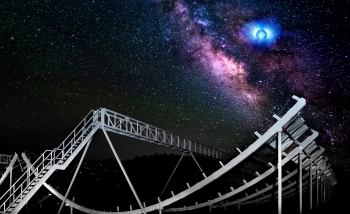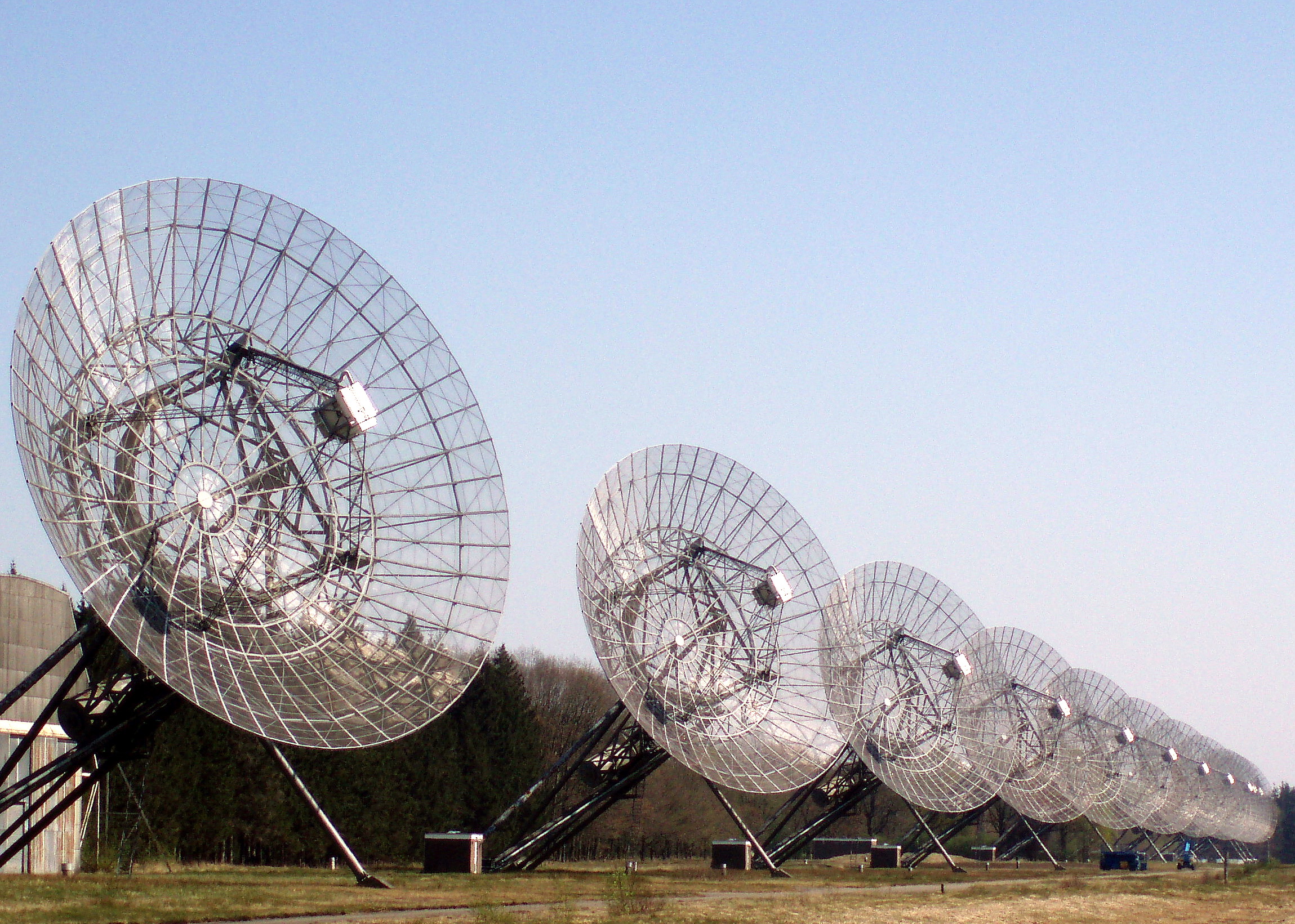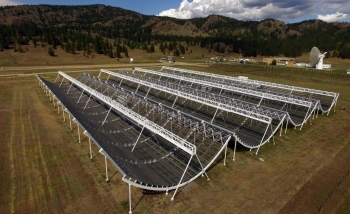Fast radio bursts were an entirely new and very mysterious phenomenon when Emily Petroff went to Australia to begin her PhD in astrophysics in 2012.
The first of these intriguing bright flashes in the night sky had only been discovered about six years earlier by American astronomer Duncan Lorimer, when he and one of his students were looking through some archival pulsar survey data.
Scientists were completely perplexed. How could these “bursts” randomly appear in the night sky for a mere millisecond, and yet be so bright that they produce more energy than the sun produces in a month? What could they be?
These questions captivated the imagination and the enthusiasm of astrophysicists just as Petroff was beginning her scientific research. She was drawn into studying them, and in fact, wrote the first PhD thesis that focused on fast radio bursts.
“It was a mystery, and everybody loves a mystery, including me,” she says about why she chose this topic.
Today, Emily Petroff is the Director, External Relations at Perimeter Institute, and is well-known to Perimeter public lecture audiences who see her hosting events and introducing guest lecturers.
Petroff is no longer actively doing research, but one of the final pieces of her previous research career was just published in Astronomy & Astrophysics.
The paper, Comprehensive analysis of the Apertif fast radio burst sample, led by Petroff’s collaborator Inés Pastor-Marazuela, represents years of work that Petroff carried out in the field of fast radio bursts. The study stems from a fast radio burst survey she was involved in while she was a postdoctoral researcher at the Netherlands Institute for Radio Astronomy (ASTRON) and during her time as an NWO Veni Fellow at the University of Amsterdam.
When Petroff arrived in the Netherlands as a postdoctoral researcher, a 50-year-old radio telescope at Westerbork was being refurbished and outfitted to study fast radio bursts. It was being upgraded with new receivers coupled to a big computer. It was called the Apertif Radio Transient System (ARTS).
Petroff was involved in just about everything to do with the deployment of the system and the survey. She was part of the commissioning team that made sure the data was flowing in properly and the scientists were getting what was expected. Then, as the Apertif survey began, she was part of the observing team and the analysis of the data.
“I spent lots of time sitting at the computer, making the telescopes move around, and doing some of the data analysis. Every time that we would find a fast radio burst, I would be helping our PhD students with the data analysis and the interpretation.”
The survey, which ran from July 2019 to February 2022, found two dozen fast radio bursts. The result adds to the evidence that these extremely powerful bursts are coming from young, magnetized and highly energetic neutron stars.
The lead author of the recently published paper is Inés Pastor-Marazuela, who is now an NWO Rubicon Research Fellow at the Jodrell Bank Center for Astrophysics (University of Manchester, UK). She was a PhD student when this survey was being done.
What she and colleagues have accomplished is an extremely comprehensive and detailed analysis of those 24 fast radio bursts, Petroff says. They examined the sample from all angles, in terms of their brightness and other technical properties.
“We were able to study these bursts in an incredible level of detail. We find that their shape is very similar to what we see in young neutron stars,” Pastor-Marazuela said in a press release from ASTRON. “The way the radio flashes were produced, and then modified as they traveled through space over billions of years, also agrees with a neutron star origin, making the conclusion even stronger,” she added.
Petroff says there have been other studies that have pointed to a neutron star origin for fast radio bursts, but this study found examples of “super-bright and super-distant” fast radio bursts.
According to ASTRON, this is remarkable, because we already know that neutron stars in our own galaxy are producing fantastic amounts of energy. “But these distant ones are somehow generating a billion times more energy than the nearby ones.”
The findings provide “a very interesting expansion to the fast radio burst parameter space,” Petroff says. In a sense, every fast radio burst tells its own story, and every one of them found at different frequencies adds to the knowledge about these phenomena in the universe, she adds.
There are still mysteries, even if there is now a stronger body of evidence linking the fast radio bursts to neutron stars.
“We still don’t understand very well exactly how these bursts are being generated,” she says. The study of fast radio bursts is still in an early stage compared to other aspects of astrophysics, but eventually, they may tell us more about what is happening in the cores and magnetic fields of neutron stars, Petroff adds.
This is why theoretical physics at places like Perimeter is important, Petroff says. Whenever something inexplicable emerges, it is the job of theorists to produce possible explanations. There were many creative theoretical possibilities that emerged when fast radio bursts were first detected. Now, we are more confident that they are coming from neutron stars, but there still are many unknowns about the mechanism that produces these bursts. Theoretical physicists are still working on that, she says.
While Petroff is no longer working directly in research, she is thrilled to see young people entering the evolving community of fast radio burst research.
“It has been wonderful watching his field take off and to see so many young people in it,” she says. “It’s heartwarming.”
Petroff is excited about the surprises yet to come.
“This field has been full of surprises already and full of serendipitous events. So, you never know. There may be more of that in the next five years. We’ll have to wait to see what the universe gives us,” she says.
For additional information, see the press release from ASTRON:
https://www.astron.nl/fast-radio-bursts-appear-to-be-neutron-stars/
À propos de l’IP
L'Institut Périmètre est le plus grand centre de recherche en physique théorique au monde. Fondé en 1999, cet institut indépendant vise à favoriser les percées dans la compréhension fondamentale de notre univers, des plus infimes particules au cosmos tout entier. Les recherches effectuées à l’Institut Périmètre reposent sur l'idée que la science fondamentale fait progresser le savoir humain et catalyse l'innovation, et que la physique théorique d'aujourd'hui est la technologie de demain. Situé dans la région de Waterloo, cet établissement sans but lucratif met de l'avant un partenariat public-privé unique en son genre avec entre autres les gouvernements de l'Ontario et du Canada. Il facilite la recherche de pointe, forme la prochaine génération de pionniers de la science et communique le pouvoir de la physique grâce à des programmes primés d'éducation et de vulgarisation.
Ceci pourrait vous intéresser

Des percées en astrophysique récompensées par le Prix Brockhouse du Canada
octobre 25, 2022




